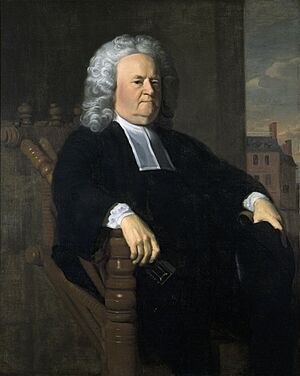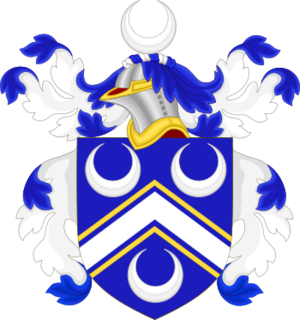Edward Holyoke facts for kids
Quick facts for kids
Edward Holyoke
|
|
|---|---|
 |
|
| President of Harvard College | |
| In office 1737–1769 |
|
| Preceded by | Benjamin Wadsworth |
| Succeeded by | John Winthrop acting |
| Personal details | |
| Born | June 26, 1689 unknown |
| Died | June 1, 1769 (aged 79) unknown |
Edward Holyoke (born June 26, 1689 – died June 1, 1769) was an important American Congregational minister. He became the 9th President of Harvard College, a very famous university. He led Harvard for many years during a time of big changes in America.
Contents
Edward Holyoke's Life and Leadership
Edward Holyoke grew up in a wealthy and influential family. His father, Elizur Holyoke Jr., was a successful businessman. He held many local government jobs. Edward's grandfather, Elizur Holyoke Sr., was also well-known. Places like Mount Holyoke and Holyoke, Massachusetts are named after him.
His Education and Early Career
Edward went to North Grammar School in Boston. Then, he went straight to Harvard College. He graduated in 1705 when he was just 16 years old. He even gave a speech for his graduating class. While at Harvard, he was known for getting into a bit of trouble. He had more fines and marks against his name than other students!
In 1708, he earned his Master's degree from Harvard. After that, he worked at Harvard as a librarian from 1709 to 1712. From 1712 to 1716, he was a tutor, which means he taught students. He was also a Fellow of the Corporation at Harvard from 1713 to 1716.
In 1714, Edward wanted to become a pastor in Marblehead. However, most of the church members chose someone else. The people who supported Holyoke decided to form a new church. Edward became the pastor for this new Second Church of Marblehead on April 25, 1716. He served there for 21 years.
Becoming President of Harvard
In 1736, Edward Holyoke was chosen to be the President of Harvard College. The Governor approved his appointment. The government even paid the Marblehead church to help them find a new minister. Holyoke officially became the 9th President of Harvard College in 1737. He took over after Benjamin Wadsworth passed away.
His time as president started during a religious movement called the Great Awakening. It also lasted until the American colonies began to have serious disagreements with England. These disagreements eventually led to the American Revolution.
New Ideas and Reforms at Harvard
When Holyoke became president, he immediately shared some bold ideas. He gave a speech where he said that all forms of government come from the people. He also believed that people could change their government if they wanted to. He was a "liberal" thinker in politics. This meant he supported new ideas and freedom.
Holyoke also believed in religious tolerance. He thought that governments should not make laws about people's spiritual beliefs. He said that every person should decide for themselves in these matters.
At first, Harvard had about 100 students. The president and four tutors taught them. As president, Holyoke was in charge of the daily operations of the college. He was also expected to teach. During his time, many changes were made to improve learning at Harvard.
One big change was how tutors taught. Before, one tutor taught a class all subjects. By 1767, tutors became specialists. This meant they taught only specific subjects. Also, students were accepted into Harvard based on their skills and smarts, not just their family's social standing. Harvard also started offering prizes for good scholarship. The old custom of flogging (whipping) students for misbehavior was stopped.
Holyoke encouraged students to explore ideas beyond their regular classes. In 1755, a special lecture series called the Dudleian Lecture began. In 1756, Harvard started public exhibitions. Students would debate, give speeches, and perform dialogues in English. This helped them improve their public speaking skills. In 1761, a professor named John Winthrop led the first American trip to observe Venus passing in front of the Sun.
Even though some people didn't see Holyoke as a brilliant thinker, he made Harvard stronger in math and science. During his presidency, Harvard built the first lab for experimental physics in North America.
Challenges and Legacy
Holyoke's presidency wasn't always smooth. In the early 1740s, a famous preacher named George Whitefield visited Cambridge. Holyoke first welcomed Whitefield to Harvard. But he later disagreed with Whitefield's religious views. Holyoke felt Whitefield was causing divisions among families and churches. Whitefield also called Harvard College a place of "impiety and sin."
In 1744, Holyoke and other Harvard faculty members defended the college. They wrote a paper warning local churches about Whitefield's views. This led to a year-long argument through written pamphlets. Despite their differences, when a fire destroyed Harvard's library in 1764, Whitefield helped. He donated books and money to rebuild the collection.
Many people thought Holyoke was a kind man. He was described as having a "noble commanding presence." Students had to stand or uncover their heads when he was around. He was also known for being a bit heavy, which earned him the student nickname "guts." People saw him as an honest man with good judgment. He was very dedicated to his duties.
Holyoke's leadership guided Harvard through challenging and changing times. Under him, Harvard College grew and became stronger. More students attended, and the college received more gifts and money. The quality of education improved. New buildings were also constructed, like Holden Chapel (1744) and Hollis Hall (1763).
Edward Holyoke was President of Harvard College for 32 years. During this time, he taught almost all of the future leaders of the American Revolution from Massachusetts. These included famous names like Samuel Adams, James Otis, John Hancock, and John Adams. His time as president was the longest in Harvard's history for a long time. He is also still considered the oldest person to ever be president of Harvard.
See also
- Holyoke Chair


